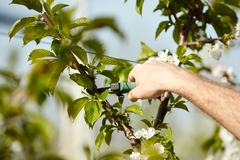
Trees are not just beautiful additions to our landscapes; they play a vital role in our environment by providing oxygen, improving air quality, conserving water, and supporting wildlife. To ensure they thrive and continue to offer these benefits, seasonal tree care is essential.
At First Choice Tree Care, we understand the intricate needs of trees throughout the year. We provide a comprehensive guide on seasonal tree care to help your greenery flourish.
Spring Tree Care: Awakening from Dormancy
-
Pruning and Trimming
Spring is the optimal time for pruning many tree species, especially deciduous ones. As trees awaken from dormancy, removing dead or damaged branches helps prevent disease and promotes healthy growth. First Choice Tree Care recommends a careful approach. Always enlist the expertise of professional arborists to ensure your trees remain healthy and structurally sound. Proper pruning enhances air circulation, sunlight penetration, and the overall aesthetics of the tree.
-
Fertilization
As trees begin to grow, their nutrient requirements increase. A balanced fertilizer rich in nitrogen, phosphorus, and potassium can support this growth. Conducting a soil test can help you understand what nutrients your soil may be lacking. Fertilization should be applied early in the season before the tree's growing cycle fully kicks in.
-
Mulching
Applying a layer of mulch around the base of the trees helps retain soil moisture, suppress weeds, and improve soil quality as it decomposes. The recommended depth of mulch is about 2-4 inches, avoiding the trunk to reduce the risk of rot.
-
Pest Monitoring
With the arrival of warmer weather, pests become more active. Early monitoring can help identify infestations before they become severe. Look for signs such as discolored leaves or a sticky residue on branches. If there is an infestation, consider organic options or contact the professionals for a safe and effective treatment plan.
Summer Tree Care: Nurturing Growth
-
Watering
Hot and dry summer months can stress trees, particularly newly planted ones. Regular watering is crucial, particularly during drought conditions. First Choice Tree Care suggests watering deeply but infrequently; this encourages the roots to grow deeper into the soil, which can enhance resilience during tough weather.
-
Inspecting for Damage
Summer storms can lead to damage from high winds and heavy rain. Conduct regular inspections for broken branches or signs of damage. Promptly remove any dangerous branches, preferably with professional assistance to ensure tree health is maintained.
-
Pest Management
Summer is an optimal time for pests to invade landscapes. Common pests, like aphids and spider mites, can wreak havoc if left unchecked. Implement integrated pest management strategies and consult with experts to find the most balanced approach to pest control.
-
Training Young Trees
Young trees benefit significantly from summer care, which includes geometric pruning to develop a strong scaffolding of branches. This will not only improve the structural integrity of the tree but also its overall appearance as it matures.
Fall Tree Care: Preparing for Dormancy
-
Final Pruning
As leaves begin to fall, it's essential to do a final check and prune any dead or diseased wood. This helps older trees remain healthy going into the winter months. First Choice Tree Care emphasizes that a well-maintained tree is better equipped to resist harsh winter conditions.
-
Deep Root Feeding
Fall is a prime time for deep root feeding, which can fortify your trees against winter stress. A specialized slow-release fertilizer allows nutrients to reach the roots while protecting the trees from root burn.
-
Mulching
Re-applying mulch in the fall is essential for moisture retention during dry winters. It also insulates the roots and serves as a barrier against temperature extremes.
-
Leaf Cleanup
Raking up fallen leaves is not just for aesthetics; it helps prevent the buildup of fungal diseases. Dispose of leaf litter responsibly, either through composting or city pickup programs.
Winter Tree Care: Protection from the Elements
-
Protection against Winter Damage
Winter can be harsh on trees. Protecting young or vulnerable trees with burlap or protective wraps can shield them from frost and wind. Make sure to remove wrappings after winter to avoid moisture buildup.
-
Snow Removal
Heavy snow accumulation can place stress on tree branches. When possible, gently remove excess snow with a broom to prevent breakage, especially from conifers that can become top-heavy.
-
Winter Pruning
Though it is generally advised against winter pruning due to visibility issues, some experts suggest it can be beneficial for certain species. Trees in dormancy are less prone to stress, so light pruning can be done, especially to maintain shape or remove crossing branches.
-
Monitor for Pests
While many pests hibernate in winter, it's crucial to monitor for signs of infestation. Early intervention can prevent pests from carrying into the spring season.
The Importance of Professional Tree Care
While many tree care tasks can be performed by property owners, there are numerous advantages to working with professionals.
First Choice Tree Care emphasizes that understanding tree biology, species needs, and local pests are critical components of effective tree care. Professionals bring knowledge of local climate conditions, common issues, and solutions that can save time and lead to healthier trees.
Conclusion
Seasonal tree maintenance is key to keeping your trees healthy and vibrant. Whether you're pruning in spring, watering in summer, or preparing for winter dormancy, these practices ensure that your trees not only survive but thrive season after season.
By implementing these essential tips, you invest in the longevity of your trees while enhancing your landscape's value and appeal.
Reach out to experts like First Choice Tree Care to achieve the best results for all your tree maintenance needs because a healthy tree is a happy tree!
